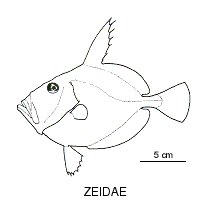-
Fish Classification
-
Class
ACTINOPTERYGII Ray-finned fishes -
Order
ZEIFORMES Dories -
Family
ZEIDAE Dories
Family ZEIDAE
Common name: Dories, Buckler Dories
Summary:
Members of the family Zeidae are very compressed deep-bodied fishes with large heads, very large protrusible mouths and long fin spines.
Dories have large bony bucklers at the bases of the dorsal and anal fins and along the ventral surface of the abdomen. Species are commmercially important.
Key to the Australian ZEIDAE genera.
Cite this page as:
Dianne J. Bray, Dories, ZEIDAE in Fishes of Australia, accessed 20 Apr 2024, https://fishesofaustralia.net.au/Home/family/151
More Info
|
Family Taxonomy |
Tyler et al. (2003) restricted the Zeidae to include two genera with five species. Both genera and three described species are known from Australia. |
|
Family Distribution |
Dories or buckler dories are benthic on the continental shelf and slope, and trawled commercially to depths of 600 m. One species enters bays and harbours. |
|
Family Description |
Zeids are characterised by having large buckler scales along the bases of the dorsal and anal fins, as well as along the ventral midline from the isthmus to the anus. They have an ovoid, laterally compressed body, large, highly protrusible jaws and small to moderate-sized eyes. |
|
Family Size |
Maximum length attained is 70 cm. |
|
Family Feeding |
Carnivores with highly protrusible jaws used to capture their prey of fishes and crustaceans. |
|
Family Reproduction |
The sexes are separate and fertilisation is external. |
|
Family Commercial |
They are important food fishes, both in Australia overseas. |
|
Author |
Dianne J. Bray |












